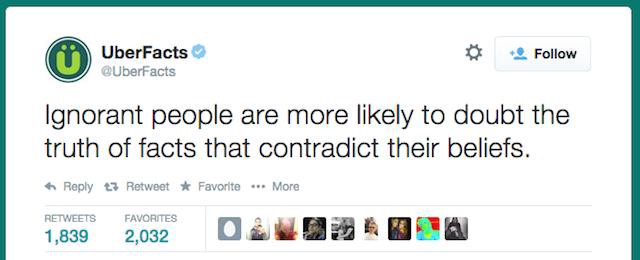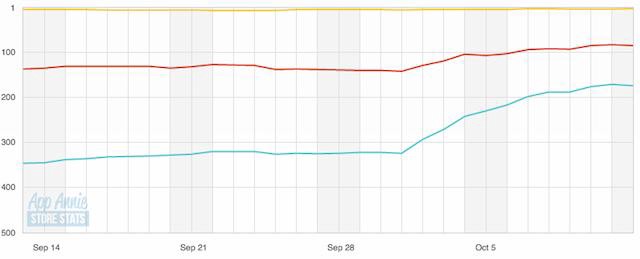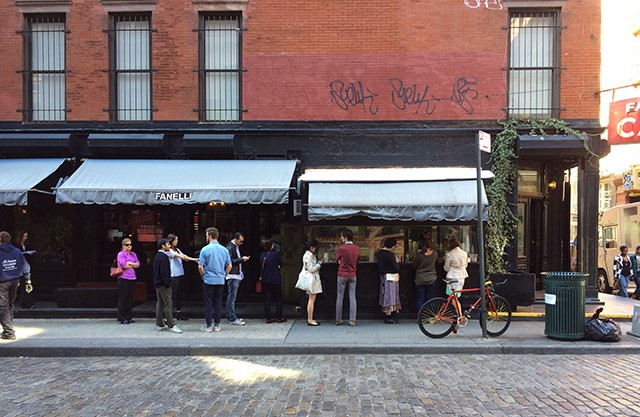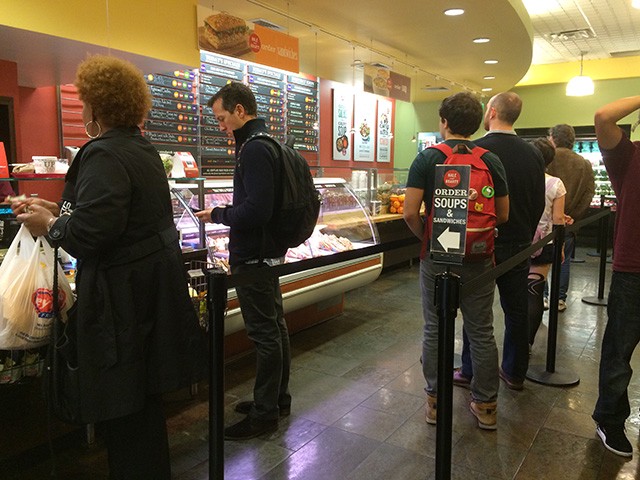The Rats Among Us
On Tuesday, Dr. Lipkin and his colleagues published their initial results in the journal mBio. Although the scientists examined just 133 rats, they found plenty of pathogens. Some caused food-borne illnesses. Others, like Seoul hantavirus, had never before been found in New York. Others were altogether new to science…So far, they have identified 18 unknown species related to viruses already shown to cause diseases in humans. Two of the new species were similar to the virus that causes hepatitis C.
One scientist told the Times that the discovery of these brand new, never-before-seen viruses in New York City rats is not “a call to wage war on rats just yet.” This scientist lives in Montana.
New York City, October 12, 2014

★★★★ A thick, spine-like streak of cirrus ran straight across the zenith. Light came into the playground sharp and sideways. The white parts of a mockingbird flashed as it crossed above the treetops. The leaves were going yellow generally. Maple wings were strewn on the padding under the swings. The spine of cloud slid off sideways, to the east. In the afternoon, the river was smooth upstream, the far hills in New Jersey crisp against the sky. The cauliflower would go in the oven, not a saute pan, to buy free time for one last look outside before sundown. Fading orange was on the building tops. “After I’m cold, I’m going to be warm,” the three-year-old said, shivering in his t-shirt, to explain why he was refusing his hoodie. One lingering pigeon flapped in a dim and stained crevice in the next building’s facade. The boy buried himself in the front of an adult’s jacket, his own still unworn. Airplanes passed, showing not only their own colors but an extra livery pattern of gold.
The @UberFacts Manifesto

Life according to wildly popular Twitter account @Uberfacts.
Part One: On Love
Love actually has nothing to do with your heart — It’s all chemical reactions inside of your brain. Our brains love music the same way it loves food and sex — We download songs we enjoy because the mind perceives them as rewards. Its possible for someone to feel “addicted to love” — Sniffing cocaine and being madly in love affect the same areas of the brain. Falling in love produces the same type of high as doing cocaine. Falling in love can act as a potent painkiller. It only takes about 0.2 seconds to fall in love. It takes a person about 15–17 months to get over a break up with someone they were in love with.
In addition to love, St. Valentine is also the patron saint of plagues.
Pixar credits its success to its anti-Disney approach — Meaning no songs, no happy village, no love story. Narcissism stems from the Greek God “Narcissus” who was a heartbreaker and was cursed by the gods to fall in love with his own reflection. The Beatles used the word “love” 613 times in their songs.
Research says people who love and feel loved tend to live longer, have better health, and make more money. 80% of people claim they love pizza! There’s a Japanese word for that “we could fall in love” feeling you sometimes get when first meeting a person — It’s “Koi No Yokan.”
During the earliest wedding ceremonies, the bride and groom would make love for the first time in front of the entire village. The drop in serotonin levels in the body when in love, is what causes us to literally obsess about someone. The brain overlooks the flaws of a person you are in love with, making it harder to leave them after they’ve hurt you. Love is more powerful than sex.
Love is more powerful than sex.
Love is more powerful than sex.

Part Two: On Dog
The average dog can learn 165 words, count up to 5, and even have a basic understanding of arithmetic. The largest amount of dogs owned by one person was 5,000. Dogs, just like humans, are more likely to steal objects in the dark when they think they cannot be seen. 7% of all Facebook accounts belong to dogs and 4% of all accounts belong to cats.
There are enough preservatives in a bag of Doritos to mummify a small dog. Parks in London are watered by more than one million gallons of dog urine every single year.
Dogs can understand that when we look at them and then stare at something, they should turn their attention to it. A new breed of cat has been discovered. It looks like a werewolf, but behaves like a dog. A cat’s brain is more similar to a human brain than it is to a dog’s brain. Humans and cats have identical regions responsible for emotion. A dog passed out from overwhelming joy after her owner came home after two years.
PETA states that Pokémon glamorizes violence against animals, in a similar way to dog fighting. In the last 11 years, PETA has killed 29,426 dogs, cats, and other domestic animals and this is where they’re kept.

Part Three: On Universe
Scientists say that the universe is precisely 13.75 billion years old. Some scientists say that if space is truly infinite, then there is probably an exact copy of you somewhere in the universe. There’s an area of the universe a billion light years away that has virtually nothing in it, not even dark matter. Our universe might just be a hologram.
Human brain cells, the universe and the internet all have similar structures. NASA experts claim that in 20 years, they will be able to answer if we are alone in the universe. There’s a theory that states our universe has collided with other universes in the past and we can view the scars by studying the night sky.
70% of our universe is made up of dark energy, however no one is sure of what that is exactly.

Part Four: On Future
Our bodies have the ability to predict the future! There was a “prophecy” written in 1595 predicting the popes of the future — The next pope corresponds with the last one on the list.
250 dead people are currently frozen, waiting to be revived with future technology. An Israeli computer scientist created an algorithm that predicts the future based on articles and tweets on the Internet. Future cell phones may be charged by micro-windmills built into the phone.
The last bite of food determines whether or not you’ll want to have it again in the future. People who trust their gut feelings are more likely to correctly predict the future. George Washington predicted the USA would only last for 20 years. By 2030, it’s predicted that 40% of all American adults will be obese. Y2K (the mass computer bug that was supposedly going to occur in the year 2000) is now predicted to occur in 2038. Sir Isaac Newton predicted that the world would end in the year 2060.
By 2020, depression will be one of the leading causes of death and disability.

Part Five: On Death
Some old myths claim that when you’re born, you’re actually crying from your death in your past life. On average people fear spiders more than they do death. The cause of Robin William’s death has been revealed — He died from asphyxia due to hanging and was found by his personal assistant.
Loneliness can literally make you sick. This feeling is associated with heart problems, viral infections, and increased chances of death. Dolphins have been witnessed torturing porpoises to death for pure fun. You can literally be “scared to death.” Fear causes your body to pump adrenaline into your blood, which can be toxic in large amounts.
Nike’s slogan “Just Do It” came from the last words of a murderer on death row.
We die because our cells die. Though they replace themselves over and over again for 70-odd years, they can’t do so forever. Jellyfish and lobsters are considered biologically immortal — They don’t age and will never die unless they are killed. The world’s oldest person lived to be 122-years-old. Her diet was olive oil, port wine, and 1 Kg of chocolate a week. Women look their oldest every Wednesday at 3:30PM.

Part Six: On @UberFacts
The game “Monopoly” was originally created to warn people of the dangers of capitalism:
By spewing out tens of thousands of the most “unimportant things you’ll never need to know,” as the UberFacts Twitter page cheekily pronounces, Sanchez has accumulated over 7 million followers since launching the account in 2009 when he was a bored college student at SUNY New Paltz. (“Total hippie town, drum circles. I only went there for a year.”)
Today he says he makes about $500,000 a year just from sponsored links. The way this works is that a company called Social Reactor, which pairs social media influencers with advertisers, supplies him with galleries or other web pages that he links to in his Tweets. He gets paid for every click those pages receive. Then there are the branded deals he’s done with companies like Ford and Paramount, wherein a simple tweet, accompanied by a link and a hashtag, becomes a virtual slot machine, gushing out thousands to tens of thousands of dollars. Plus the apps. The iOS app, which has been downloaded 1.5 million times, is estimated to generate $60,000 a week from advertising, though that has not yet been implemented.
“There are so many tweets going out each day that it was tough for one person, being me, to make sure that every single one of them was completely true,” he says, adding, “Anything that I posted up there, I thought was true. And I’m always bummed to find out that it isn’t.”
Money isn’t made out of paper, it’s made out of cotton. Touching or feeling money can help you overcome negative physical and emotional experiences. Studies at Princeton University have found that money can buy happiness when you make up to $75,000 a year.
Who Leaves Half of Their Dog's Poop Behind on the Sidewalk?
Who Leaves Half of Their Dog’s Poop Behind on the Sidewalk?
by Matthew J.X. Malady
if you let your dog poop on a high-traffic sidewalk & make a sad gesture to pick it up but leave most of it you are simply a terrible human
— Jen Doll (@thisisjendoll) September 27, 2014
Jen! So what happened here?
It was a beautiful Saturday and I was spending it in a rather stereotypically Brooklyn way, but you know, I’m not going to hide in shame from the truth of my life. I had just done yoga, and then gone to the farmer’s market for fresh vegetables that would soon rot in my refrigerator. I was sitting on the stoop with my friend Blair, with whom I had yoga-ed and marketed, and we were enjoying the sun and chatting and watching people walk by. I live on a pretty high-traffic street, especially on a sunny Saturday, so there is lots of good people watching. As we sit, a short, older man with salt-and-pepper hair lugging a wheelie suitcase and walking a small dog — like a Yorkie type of thing, or a slightly bigger kind of terrier — stops and lets the dog poop, basically right in front of us, on this high-traffic street, which is in itself a bit rude and disgusting and graphic. (Plus, poor dog, I think it was ashamed; it looked ashamed.) Then the man bends over and picks up HALF the poop with a bag, leaving two large pieces of it on the sidewalk. I open my mouth, but I can’t say anything because I am frozen in horror and disgust and shock and most of all, confusion. Did he not SEE all the poop? Did he purposely leave half behind? Who picks up half the dog poop?
The man walks toward a trash can, I suppose commending himself for being such a responsible citizen, and I finally recover my powers of speech and say, “THAT GUY LEFT HALF THE POOP ON THE SIDEWALK!” And Blair says something like, “Oh my God, that’s disgusting and did you see his suitcase, he is probably renting an Airbnb in our neighborhood.”
Blair and I frequently talk about how such people are ruining the neighborhood, but this was a physical, fecal representation of that fact.
We sat for a few more minutes pondering injustice in the world, and I’m like, “Someone is going to step in that immediately,” and she’s like, “Oh yes they are,” and I’m doubly annoyed at the poop-leaver because suddenly it’s like I have to be the one at the gym telling everyone the elliptical they’re about to get on is broken and I can’t deal with that sort of responsibility, plus HE’S the jerk who left the poop, and it’s not like I work at the gym, I’m just there for a workout. Why do I have to be on poop-watch?
We see a group of women walking directly toward the poop, talking to each other and not looking where they’re going, and I open my mouth to be like “Watch out, there’s poop!” but nothing comes out, and this woman in large plastic sandals just tromps on the poop, leaving it a gross green-brown smudge on the pavement. Which, I suppose, was a near kind of relief because once she stepped on it there was less left for anyone else to step on, and she wasn’t wearing flip-flops, but still.
This woman, also, did not seem to notice the poop.
Blair and I look at each other in disgust, and she’s like, “I gotta go,” and I’m like, “Yeah, I think I need to go inside now,” and I imagine we both felt a bit dirty and gross for a while. We have not mentioned the poop-cident since.
During the time you’ve spent in New York, what other frustrating dog poop etiquette breaches have you run across? I ask mainly because I’m wondering where this incident ranks in the pantheon of dog defecation–related jerk moves that you’ve witnessed over the years.
I have lived in New York for like fifteen years at this point, my god, maybe longer, I don’t even want to talk about it. I wrote for the Village Voice and a frequent blog item involved poop wars in various neighborhoods. Things get vicious! I think in Brooklyn somewhere a person was letting their dog poop everywhere and someone else bagged up the poop and hung it from a tree with a note? (Maybe I made that up.) There’s a sign on another block near my house that says, “DON’T LET YOUR DOG POOP AND PEE HERE.” There is an internet-full of passive aggressive and aggressive-aggressive notes about where people have let their dogs poop and how everything is terrible.
I have seen a lot of poop in my days in New York. Most of it, I think, from dogs. Certain neighborhoods seem to get it worse than others. When I lived in the East Village, there was a block nearby I referred to as “Poopville.” One should avoid walking on such blocks. But how does it get that bad? Is it when one person goes off the rails, and then everyone else is like, well, the neighborhood’s already poopy, so let’s give up trying? Is there a snowball effect to poop problems?
Also: I have seen poop IN BAGS left on the street. Who does that? That may be the worst offense.
If you have a dog in the city, you have to know that you have to pick up the poop. And this guy clearly knew; after all, he did pick up part of it — that’s the weirdest part of it. I don’t know if he was intentionally being evil or just nearsighted, but either way, that sort of behavior is dangerous. Someone’s gonna get hurt.
Lesson learned (if any)?
I think that the single-most frustrating etiquette thing that classifies certain types of people in the city as bad citizens, or bad temporary citizens, is when they are blatantly — even if shallowly and superficially, in a way that causes more annoyance than direct harm — inconsiderate to others. So, when you’re standing on the steps to the subway talking on your phone and blocking people, or when you walk 5-abreast slowly on a crowded sidewalk, or when you push your way onto a train without letting people off first . . . or when you fail to pick up your dog’s poop — ALL OF IT — you show such disregard for the other people living here, whom your actions are affecting. In the social compact of urban life you have to be aware of others, and while you don’t have to loudly warn them when they’re about to step in poop (I mean, I should have, but my voice wasn’t working in that moment, the poop broke me) you should at the very least make sure you don’t leave poop on sidewalks for them to step in.
Also, I will never rent my apartment out via Airbnb.
Just one more thing.
If I ever write a dystopia or horror novel set in New York City, I think my villain will have a wheelie suitcase with him at all times, and also a small Yorkie.
Join the Tell Us More Street Team today! Have you spotted a tweet or some other web thing that you think would make for a perfect Tell Us More column? Get in touch through the Tell Us More tip line.
Matthew J.X. Malady is a writer and editor who was in New York but is now in Berkeley.
Photo by zendritic
Moves Borrowed
“I am the Jonah Lehrer of sex, a serial plagiarist of stunning bravado and insouciance. So are you.”
Pathogen Privilege
Amanda Uhry, who runs a consultancy called Manhattan Private School Advisors, which, as its name suggests, helps parents through the private-school application process, said she recently turned down a half-dozen clients when she discovered that they were opposed to vaccination. For a long while she had never inquired about the issue, but a few years ago, a child she was working with missed his kindergarten interview because of whooping cough, which left her stunned. “I thought, Whooping cough? Who gets whooping cough anymore?” she said.
While the Times strains to paint the wealthy parents New York City as marginally more reasonable than the wealthy parents of Los Angeles when it comes to anti-vaccination fervor, it’s clear that their pampered, all-organic, macrobiotic-fed, micro-managed children — who are able to skirt the city’s otherwise rigorous vaccination requirements, thanks to their malevolently ignorant parents’ preening — are going to reintroduce us all to antiquated diseases which had otherwise been wiped out of the public sphere. Call it pathogen privilege.
The American Ebola Story

This is the App Store ranking history for an app called Plague Inc. It’s a game in which players design and deploy a disease into the world with the goal of infecting the entire planet — to win the game you must infect every country, no exceptions. The game has been around for a while — the CDC invited its creator to speak to the agency’s staff last year. The pretense, according to a CDC spokesperson: “Meeting with industry leaders is a great way to learn more about reaching new audiences through mobile apps.” The game’s sales spiked on October 1st, immediately after the hospitalization of Thomas Duncan in Dallas. Ebola felt suddenly close for Americans, captivating our imaginations. So we downloaded an Ebola game.
This may have been the moment when the American’s public’s interest in Ebola went from real but removed to real and urgent; this was also the moment that television coverage of the disease took on a new and ugly form. Not that it was particularly great before: The earlier faraway-Ebola narrative played up the gruesome details of the disease while simultaneously assuring viewers that its spread could be blamed on infrastructure weaknesses and destructive superstitions in affected countries, problems that were characterized as uniquely African (or, at least, not American). Experts would file through the TV studios, repeating their mantras: No contact, no spread. Don’t touch dying patients, follow the rules, and you’ll be fine.
Now that people are paying attention to cable news for breaking updates about a domestic disease, as opposed to swashbuckling warzone-style coverage of a foreign disease, the tone has changed. I watched a series of segments yesterday, on CNN, in which the hosts’ sole concern was to assign blame: Had the hospital broken protocol at any point in treating Thomas Duncan, leading to the infection of a nurse? Had there been even more protocol breaches in the course of her hospitalization? Who can we get fired for the appearance and spread of this natural pathogen? Heads must roll! It was like a Fox News segment about Benghazi, circa election 2012. There were expert guests, but they weren’t delivering any advice, condescending or otherwise. They seemed a out of their elements. In the studio where they had previously been tasked with explaining the origins and spread of an unfamiliar disease that has been devastating for thousands of people, they were now tasked with assigning responsibility and guilt in a single case.
This is something that the disaster movies don’t quite get right when they show imagined news segments in the background, updating viewers about progress of whatever horrible event, with anchors cautiously then nervously then urgently update viewers on what’s happening in the world: The real versions of these clips would be confusing and worthless. They would only distract from the plot.
New York City, October 9, 2014

★★★★ Colored party lights flashed from a dark apartment, persistently, in irregular sequence: shiny hanging decorations, twisting and catching the sun. The rope from the building-maintenance rigging whipped back and forth outside the window. Dilute white washed the sky, and there were yellow tips on the honeylocust branches. The air was cool on the cheeks. A little waddling dog wore a dog-garment. As Broadway opened out to Columbus Circle, the brightness accumulated like floating dust, forcing a sneeze. A crew was up on a lift stringing lights on the trees. Downtown the clouds were white scratchings on the blue. For a moment in late afternoon, a beam of light succeeded in penetrating the gloom of the office. Leaves and grit scraped along the sidewalk. Light was up in the cornices, and the luxury tower downtown was as bright as a butter knife. Even in this season of sunsets, the opalescent colors at day’s end were a surprise.
This Week in Lines: Soup
by Jake Gallagher

12:46 PM Thursday, October 9 — Soup kiosk
Location: Prince and Mercer
Length: Eleven people, five cardigans
Weather: 68 and partly cloudy
Crowd: Solo Soho soup slurpers
Mood: Noodle-y
Wait time: Five minutes
Lingering question: Do you want bread with that?

Time and date: 11:30 AM Friday, October 10 — Hale & Hearty
Location: 23rd Street
Length: Five people, two cardigans, two tees
Weather: 61 and partly cloudy
Crowd: Soup-seeking SVA students
Mood: Clammy
Wait time: Two minutes
Lingering question: Do you want a salad with that?

11:53 AM Friday, October 10 — Ippudo
Location: 4th Avenue Between 9th and 10th Streets
Length: Eight people, three windbreakers
Weather: 63 and partly cloudy
Crowd: Hopefully just tourists at this point
Mood: Broth-y
Wait time: Fifteen minutes
Lingering question: Do you want a food coma with that?
Jake Gallagher is a writer for A Continuous Lean and other places.
